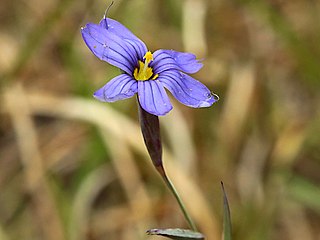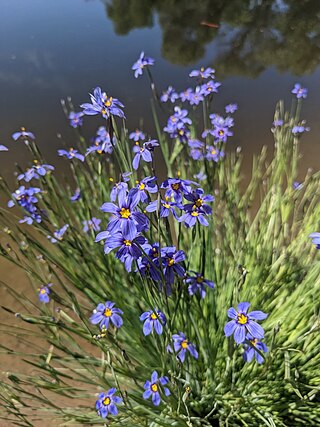
Sisyrinchium bellum, the western blue-eyed grass or Californian blue-eyed grass, is the common blue-eyed grass of California and Oregon in and west of the Sierra Nevada, its range extending south into Baja California. In parts of its range, western blue-eyed grass has previously been classified as Sisyrinchium eastwoodiae, S. greenei and S. hesperium, but these names are now considered synonyms.

Muilla coronata is a species of flowering plant known by the common name crowned muilla. It is native to the deserts of eastern California and southern Nevada, where it is found in scrub and Joshua Tree woodland habitat, as well as the slopes of nearby mountains. It is a perennial growing from a corm and reaching no more than 15 centimeters in height. The flowering stem bears an umbel-shaped array of up to 10, but usually fewer, flowers on pedicels up to 3 centimeters long. Each flower has six tepals which are white in color, often with a blue tinge inside and a greenish tinge on the outer surfaces. At the center of the flower are six stamens with wide white petal-like filaments. The filaments are partially fused into an erect, cylindrical "crown".

Olsynium douglasii is a species of flowering plant in the iris family (Iridaceae). Common names include Douglas' olsynium, Douglas' grasswidow, grass-widow, blue-eyed grass, purple-eyed-grass, and satin flower, It is the only species in the genus Olsynium in North America, the remaining 11 species being from South America. It was formerly treated in the related genus Sisyrinchium. Despite the common names, it is not a true grass (Poaceae).

Sisyrinchium montanum, the blue-eyed-grass, American blue-eyed-grass, or strict blue-eyed grass, is a grass-like species of plant from the genus Sisyrinchium, native to northern North America from Newfoundland west to easternmost Alaska, and south to Pennsylvania in the east, and to New Mexico in the Rocky Mountains. It has also been introduced to parts of France, likely during the First World War.

Allium campanulatum is a species of wild onion known by the common name dusky onion or Sierra onion. This is a flowering plant native to the western United States from southeastern Washington and northern Oregon to southern California, and western Nevada. The dusky onion grows in foothills and mountains, especially in dry areas, such as chaparral habitats.

Juncus capitatus is a species of rush known by the common names dwarf rush and leafybract dwarf rush. It is native to Europe, Asia and North Africa. It is also an introduced species in parts of North America such as California and the Gulf Coast. It grows in moist areas, such as wet sand, vernal pools, and ditches.

Allium monticola is an uncommon species of wild onion known by the common name San Bernardino Mountain onion. It is endemic to southern California, where it is found in the Transverse Ranges and the northernmost section of the Peninsular Ranges. It has been reported from San Bernardino, Los Angeles, Orange, Ventura and Santa Barbara Counties.

Sisyrinchium idahoense, the Idaho blue-eyed grass, is a perennial that is native to western North America. It is not a true grass, but is instead in the family Iridaceae.

Monochoria vaginalis is a species of flowering plant in the water hyacinth family known by several common names, including heartshape false pickerelweed and oval-leafed pondweed.

Rumex pulcher is a species of flowering plant in the knotweed family known by the common name fiddle dock. It is native to Eurasia and North Africa and it can be found elsewhere, including parts of North America, as an introduced species and a roadside weed. It is quite variable in appearance, and some authorities divide it into several subspecies that are more or less distinguishable. In general, it is a perennial herb producing a slender, erect stem from a thick taproot, approaching 70 centimeters in maximum height. The top of the plant may bend, especially as the fruit develops. The leaves are up to 10 or 15 centimeters long and variable in shape, though often oblong with a narrow middle in the rough shape of a fiddle. The inflorescence is made up of many branches, each an interrupted series of clusters of flowers with up to 20 in each cluster, each flower hanging from a pedicel. The flower has usually six tepals, the inner three of which are edged with teeth and have tubercles at their centers.

Sisyrinchium californicum is a species of flowering plant in the iris family known by the common names golden blue-eyed grass, yellow-eyed-grass, and golden-eyed-grass. It is native to the west coast of North America from British Columbia to central California, where it grows in moist habitat, often in coastal areas.

Sisyrinchium elmeri is a species of flowering plant in the family Iridaceae known by the common name Elmer's blue-eyed grass. It is endemic to California, where it is known from many of the mountain ranges from the Klamath Mountains through the Sierra Nevada to the San Bernardino Mountains. It grows in moist habitat types such as meadows and bogs.

Sisyrinchium funereum is an uncommon species of flowering plant in the family Iridaceae known by the common names Funeral Mountain blue-eyed grass and Death Valley blue-eyed-grass. It is endemic to the Mojave Desert of the United States, where it is known only from the Funeral Mountains and Death Valley area in eastern California, and the Ash Meadows area just over the border in Nevada. It grows in wet, highly alkaline habitat, such as seeps and mineral springs.

Triteleia hyacinthina is a species of flowering plant known by the common names white brodiaea, white tripletlily, hyacinth brodiaea, and fool's onion. It is native to western North America from British Columbia to Idaho to central California. Its habitat includes grassland and vernally moist areas such as meadows and vernal pools. It is a perennial herb growing from a corm. It produces two or three basal leaves up to 40 centimeters (16 in) long by 2 centimeters (0.79 in) wide. The inflorescence arises on an erect stem up to 60 centimeters (24 in) tall and bears an umbel-like cluster of many flowers. Each flower is a funnel-shaped bloom borne on a pedicel up to 5 centimeters (2.0 in) long. The flower is white, often tinged purple along the tubular throat, with six green-veined tepals. There are six stamens with white, yellow, or occasionally blue anthers.

Sisyrinchium dichotomum is a rare species of flowering plant in the iris family known by the common names wishbone blue-eyed grass, white irisette, and reflexed blue-eyed grass. It is native to North Carolina and South Carolina in the United States, where fewer than ten populations remain in four counties. It is threatened by the loss and degradation of its habitat and is a federally listed endangered species of the United States.

Sclerocactus papyracanthus is a species of cactus known by the common names paperspine fishhook cactus, grama grass cactus, paper-spined cactus, and toumeya. It is native to North America, where it occurs from Arizona to New Mexico to Texas and into Chihuahua, Northeastern Mexico.

Potentilla basaltica is a species of flowering plant in the rose family known by the common names Soldier Meadows cinquefoil and basalt cinquefoil. It is endemic to a small area of the Modoc Plateau and Warner Mountains in northeastern California and northwestern Nevada.
Sisyrinchium sarmentosum is a species of flowering plant in the iris family known by the common names mountain blue-eyed grass and pale blue-eyed-grass. It is native to the Pacific Northwest of North America, where it is known from a part of the Cascade Mountains in Washington and Oregon.

Sisyrinchium atlanticum, the eastern blue-eyed grass or Atlantic blue-eyed-grass, is a species of flowering plant in the family Iridaceae.

Sisyrinchium demissum, commonly called stiff blue-eyed grass is small member of the iris family in genus Sisyrinchium. The plant's natural range is in the western United states and northern Mexico. It is sometimes grown in garden settings in its native range.


















